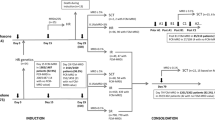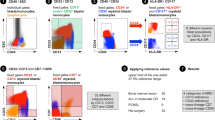Abstract
Minimal residual disease (MRD) after initial therapy is integral to risk stratification in B-precursor and T-precursor acute lymphoblastic leukemia (B-ALL, T-ALL). Although MRD determines depth of remission, remission remains defined by morphology. We determined the outcomes of children with discordant assessments of remission by morphology vs. flow cytometry using patients age 1–30.99 years enrolled on Children’s Oncology Group ALL trials who underwent bone marrow assessment at the end of induction (N = 9350). Morphologic response was assessed locally as M1 (<5% lymphoblasts; remission), M2 (5–25%), or M3 (>25%). MRD was centrally measured by flow cytometry. Overall, 19.8% of patients with M2/M3 morphology had MRD < 5%. M1 with MRD ≥ 5% was less common in B-ALL (0.9%) than T-ALL (6.9%; p < 0.0001). In B-ALL, M1/MRD ≥ 5% was associated with superior 5-year event-free survival (EFS) than M2/MRD ≥ 5% (59.1% ± 6.5% vs. 39.1% ± 7.9%; p = 0.009), but was inferior to M1/MRD < 5% (87.1% ± 0.4%; p < 0.0001). MRD levels were higher in M2/MRD ≥ 5% than M1/MRD ≥ 5% patients. In T-ALL, EFS was not significantly different between M1/MRD ≥ 5% and M2/MRD ≥ 5%. Patients with morphologic remission but MRD ≥ 5% have outcomes similar to those who fail to achieve morphological remission, and significantly inferior to those with M1 marrows and concordant MRD, suggesting that flow cytometry should augment the definition of remission in ALL.
This is a preview of subscription content, access via your institution
Access options
Subscribe to this journal
Receive 12 print issues and online access
$259.00 per year
only $21.58 per issue
Buy this article
- Purchase on Springer Link
- Instant access to full article PDF
Prices may be subject to local taxes which are calculated during checkout


Similar content being viewed by others
References
Pui CH, Yang JJ, Hunger SP, Pieters R, Schrappe M, Biondi A, et al. Childhood acute lymphoblastic leukemia: progress through collaboration. J Clin Oncol. 2015;33:2938–48.
Borowitz MJ, Devidas M, Hunger SP, Bowman WP, Carroll AJ, Carroll WL, et al. Clinical significance of minimal residual disease in childhood acute lymphoblastic leukemia and its relationship to other prognostic factors: a Children’s Oncology Group study. Blood. 2008;111:5477–85.
Borowitz MJ, Wood BL, Devidas M, Loh ML, Raetz EA, Salzer WL, et al. Prognostic significance of minimal residual disease in high risk B-ALL: a report from Children’s Oncology Group study AALL0232. Blood. 2015;126:964–71.
Conter V, Bartram CR, Valsecchi MG, Schrauder A, Panzer-Grumayer R, Moricke A, et al. Molecular response to treatment redefines all prognostic factors in children and adolescents with B-cell precursor acute lymphoblastic leukemia: results in 3184 patients of teh AIEOP-BFM ALL 2000 study. Blood. 2010;115:3206–14.
Schrappe M, Valsecchi MG, Bartram CR, Schrauder A, Panzer-Grumayer R, Moricke A, et al. Late MRD response determines relapse risk overall and in subsets of childhood T-cell ALL: results of the AIEOP-BFM-ALL 2000 study. Blood. 2011;118:2077–84.
Campana D, Pui CH. Minimal residual disease-guided therapy in childhood acute lymphoblastic leukemia. Blood. 2017;129:1913–8.
Van der Velden VH, Corral L, Valsecchi MG, Jansen MW, De Lorenzo P, Cazzaniga G, et al. Prognostic significance of minimal residual disease in infants with acute lymphoblastic leukemia treated within the Interfant-99 protocol. Leukemia. 2009;23:1073–9.
Vora A, Goulden N, Mitchell C, Hancock J, Hough R, Rowntree C, et al. Augmented post-remission therapy for a minimal residual disease-defined high-risk subgroup of children and young people with clinical standard-risk and intermediate-risk acute lymphoblastic leukaemia (UKALL 2003): a randomised controlled trial. Lancet Oncol. 2014;15:809–18.
Schrappe M, Hunger SP, Pui CH, Saha V, Gaynon PS, Baruchel A, et al. Outcomes after induction failure in childhood acute lymphoblastic leukemia. N Engl J Med. 2012;366:1371–81.
Kreft A, Holtmann H, Schad A, Kirkpatrick CJ. Detection of residual leukemic blasts in adult patients with acute T-lymphoblastic leukemia using bone marrow trephine biopsies: Comparison of fluorescent immunohistochemistry with conventional cytologic and flow-cytometric analysis. Pathol Res Pract. 2010;206:560–4.
Longacre TA, Foucar K, Crago S, Chen IM, Griffith B, Dressler L, et al. Hematogones: a multiparameter analysis of bone marrow precursor cells. Blood. 1989;73:543–52.
O’Connor D, Moorman AV, Wade R, Hancock J, Tan RMR, Bartram J, et al. Use of minimal residual disease assessment to redefine induction failure in pediatric acute lymphoblastic leukemia. J Clin Oncol. 2017;35:660–7.
Larsen EC, Devidas M, Chen S, Salzer WL, Raetz EA, Loh ML, et al. Dexamethasone and high-dose methotrexate improve outcome for children and young adults with high-risk b-acute lymphoblastic leukemia: a report from children’s oncology group study AALL0232. J Clin Oncol. 2016;34:2380–8.
Winter SS, Dunsmore KP, Devidas M, Eisenberg N, Asselin BL, Wood BL, et al. Safe integration of nelarabine into intensive chemotherapy in newly diagnosed T-cell acute lymphoblastic leukemia: Children’s Oncology Group Study AALL0434. Pediatr Blood Cancer. 2015;62:1176–83.
Schultz KR, Pullen DJ, Sather HN, Shuster JJ, Devidas M, Borowitz MJ, et al. Risk- and response-based classification of childhood B-precursor acute lymphoblastic leukemia: a combined analysis of prognostic markers from the Pediatric Oncology Group (POG) and Children’s Cancer Group (CCG). Blood. 2007;109:926–35.
Wood BL. Flow cytometric monitoring of residual disease in acute leukemia. In: Czader M, editor. Hematologic malignancies. New York: Springer Science and Business; 2013. p. 999.
Roshal M, Fromm JR, Winter SS, Dunsmore KP, Wood BL. Immaturity associated antigens are lost during induction for T cell lymphoblastic leukemia: implications for minimal residual disease detection. Cytom B Clin Cytom. 2010;78:139–45.
Heerema NA, Carroll AJ, Devidas M, Loh ML, Borowitz MJ, Gastier-Foster JM, et al. Intrachromosomal amplification of chromosome 21 is associated with inferior outcomes in children with acute lymphoblastic leukemia treated in contemporary standard-risk Children’s oncology group studies: a report from the children’s oncology group. J Clin Oncol. 2013;31:3397–402.
Coustan-Smith E, Mullighan CG, Onciu M, Behm FG, Raimondi SC, Pei D, et al. Early T-cell precursor leukaemia: a subtype of very high-risk acute lymphoblastic leukaemia. Lancet Oncol. 2009;10:147–56.
Kaplan E, Meier P. Nonparametric estimation from incomplete observations. J Am Stat Assoc. 1958;53:457–81.
Peto R, Pike MC, Armitage P, Breslow NE, Cox DR, Howard SV, et al. Design and analysis of randomized clinical trials requiring prolonged observation of each patient. II. analysis and examples. Br J Cancer. 1977;35:1–39.
Arber DA, Orazi A, Hasserjian R, Thiele J, Borowitz MJ, Le Beau MM, et al. The2016 revision to the World Health Organization classification of myeloid neoplasms and acute leukemia. Blood. 2016;127:2391–405.
Pui CH, Campana D, Pei D, Bowman WP, Sandlund JT, Kaste SC, et al. Treating childhood acute lymphoblastic leukemia without cranial irradiation. N Engl J Med. 2009;360:2730–41.
Vrooman LM, Sevenson KE, Supko JG, O’Brien J, Dahlberg SE, Asselin BL, et al. Post-induction dexamethasone and individualized dosing of Escherichia coli L-asparaginase each improve outcome of children and adolescents with newly diagnosed acute lymphoblastic leukemia: results from a randomized study—Dana-Farber Cancer Institute ALL Consortium Protocol 00-01. J Clin Oncol. 2013;31:1202–10.
McKenna RW, LaBaron WT, Aquino DB, Picker LJ, Kroft SH. Immunophenotypic analysis of hematogones (B-lymphocyte precursors) in 662 consecutive bone marrow specimens by 4-color flow cytometry. Blood. 2001;98:2498–507.
Karawajew L, Dworzak M, Ratei R, Rhein P, Gaipa G, Buldini B, et al. Minimal residual disease analysis by eight-color flow cytometry in relapsed childhood acute lymphoblastic leukemia. Haematologica. 2015;100:935–44.
Inaba H, Coustan-Smith E, Cao X, Pounds SB, Shurtleff SA, Wang KY, et al. Comparative analysis of different approaches to measure treatment response in acute myeloid leukemia. J Clin Oncol. 2012;30:3625–32.
Funding
This study was supported by National Institutes of Health, National Cancer Institute grants (U10CA098543, U10CA098413, U10CA180886, and U10CA180899) and by St. Baldrick’s Foundation. In-kind support was also provided by Becton Dickinson Biosciences (San Jose, CA). SG is supported by a young investigator grant from the Alex’s Lemonade Stand Foundation. MLL is the Benioff Chair of Childhood Health and the Deborah and Arthur Ablin Chair of Pediatric Molecular Oncology at the Benioff Children’s Hospitals, UCSF SF, CA. SPH is the Jeffrey E. Perelman Distinguished Chair in the Department of Pediatrics, Children’s Hospital of Philadelphia
Author information
Authors and Affiliations
Corresponding author
Ethics declarations
Conflict of interest
The authors declare that they have no conflict of interest.
Electronic supplementary material
Rights and permissions
About this article
Cite this article
Gupta, S., Devidas, M., Loh, M.L. et al. Flow-cytometric vs. -morphologic assessment of remission in childhood acute lymphoblastic leukemia: a report from the Children’s Oncology Group (COG). Leukemia 32, 1370–1379 (2018). https://doi.org/10.1038/s41375-018-0039-7
Received:
Revised:
Accepted:
Published:
Issue Date:
DOI: https://doi.org/10.1038/s41375-018-0039-7
This article is cited by
-
Prognostic implications of CD9 in childhood acute lymphoblastic leukemia: insights from a nationwide multicenter study in China
Leukemia (2024)
-
One-point flow cytometric MRD measurement to identify children with excellent outcome after intermediate-risk BCP-ALL: results of the ALL-MB 2008 study
Journal of Cancer Research and Clinical Oncology (2023)
-
A simple algorithm with one flow cytometric MRD measurement identifies more than 40% of children with ALL who can be cured with low-intensity therapy. The ALL-MB 2008 trial results
Leukemia (2022)
-
IgH gene rearrangement by PCR as an adjunct to flow cytometric analysis for the detection of minimal residual disease in patients with B lymphoblastic leukemia
Journal of Hematopathology (2020)
-
Minimal/Measurable Residual Disease Detection in Acute Leukemias by Multiparameter Flow Cytometry
Current Hematologic Malignancy Reports (2018)



